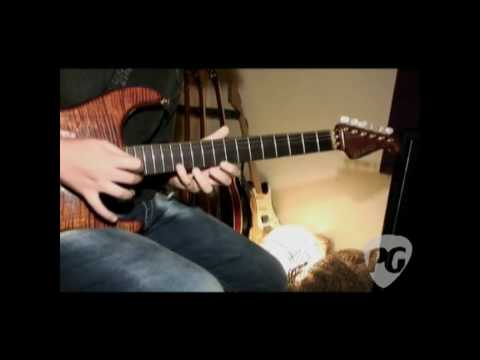Very interesting!
Very cool indeed. Everything he talks about makes sense, getting it to ‘work’ for you however is the challenge as we’re all so different 
Of course, making it work is a different story.
It is just that this is something I did not think of being that relevant, and which helps me already after changing my pick grip.
Anton seems to think a lot about these kind of details, which (in my opinion), plays a major part of having such unbelievable technique.
Interesting observations indeed!
As far as I can see also the bit of the thumb where the two joints meet (forgot the name  ) could be used for the same purpose, it’s even more “bony” than the thumbtip.
) could be used for the same purpose, it’s even more “bony” than the thumbtip.
I think Steve Lukather from Toto holds it like that:
Yes, I have tried that in the past. Did not work for me because i did not had the same control opposed to holding it more to the tip of the thumb.
This is an idea that MAB and Guthrie Govan both talk about too, though I think both of them emphasize the choice of plectrum itself, and talk less about the role that movement within your grip could play. I think Guthrie uses the analogy of trying to draw with a normal pencil versus a floppy rubber pencil.
I take a similar approach for fast alternate picking, but for other things, I sometimes loosen my grip to modulate my attack.
Interestingly, I’ve seen Rob Chapman advocate for slight “floppiness” in the pick grip even for fast alternate picking. It’s not intuitive to me, but I think he’s arguing for the kind of “resilience against small accuracy errors” that often leads teachers to recommend thin, flexible picks to guitar beginners. Maybe a small amount of floppiness helps prevent “accidental catching on the string” in instances where the attack angle of the pick isn’t neutral enough relative to the line of the picking motion?
That’s what I do actually. I somehow switched to this position couple of months ago. I was wondering if this was okay, but since it doesn’t give me any problems I let my hand to do whatever it wants.
Don’t know about MAB but Guthrie indeed is refering to the stiffness of the pick with the rubber pencil comparison.
I never understood the floppiness for faster picking.
For slower stuff I sometimes do this to get a certain sound, but for faster picking that does not working for me.
A thick/stiff pick you can’t hold to tight of course, but to loose, as where it gets floppy, for faster stuff is a no go for me.
I’ve tried the two-finger method and whilst stable, it seemed to increase tension versus the standard one finger side-pad I’m used to so YMMV.
Anton is phenomenal, but his ‘one-size fits all’ approach is a little too anecdotal and stringent given the huge variation amongst elite players. I’m still experimenting with his ‘guidelines’ but I have had similar results/insights trying the info troy has presented so well in the primer and other lessons.
I think the problem with trying to find a universal solution is that in my experience all methods work. Whether it is wrist USX, wrist DSX, forearm blend or elbow etc once you’re comfortable they all seem to feel similar and yield comparable results.
Anton is able to play/pick things I have never see anybody do that clean at those speeds.
Even a guy like Rick Graham is just stunned by what Anton is able to do.
Therefore I believe he found some extra details that got him there.
The question of course is: are those gonna work for everybody. I don’t know… but for sure wanna give it a try.
I did give a shot to this thumb-tip thing and it just does not seem to work with the shape of my hands/fingers. Of course I may have more trial and error to do and may eventually find something that works.
But in general I would also like to challenge the idea that you need a stiff pick or more generally a pick that does not move to pick fast. I can pick at my fastest speed (which admittedly is well below Anton’s) with anything from 0.5mm to 2mm.
Guthrie’s metaphor of a floppy rubber pencil also misses the point in my opinion: you can totally write with a rubber pencil / pick with a floppy pick. Their response is not random, it’s fully predictable and exploitable - you just need to get a feel for it.
Also Mike Stern comes to mind, whose technique is pretty much based on a loose grip and a pick that moves. Sure he is not a full-on shredder, but I don’t think anyone can say he’s a bad picker or has a bad tone.
That being said, I still find Anton’s observations very useful if the objective is to have a very stable / unmovable pick.
Some valid points!
I disagree with you on the rubber pencil thing.
For sure you could learn to write clean with a looot of practice.
But, how long will it take you to get there, and can you realy learn to write as fast and that clean with it compared to a normal pencil? I believe it would take you much longer and eventually you only can write realy clean at a lower speed.
Of course Mike Stern is a great player and does what he does very well! The way he holds the pick and strikes the strings gives him also his smooth vocal-like sound. But, there is nothing he plays I can’t do on a technical level as far as picking goes.
With Anton it is quitr the opposite; i cant’t play a damn thing he does that clean at those speeds!
I believe these exceptional picking abilities must be in the details he explored and mentions.
I will implement them and practice for some period to see if it works.
Maybe in the end I was wrong and it won’t work at all for me, but for now I have to believe it will.
Cool I’m very curious to know how these ideas will work for you, let us know!
By the way, are there any picking patterns in particular that Anton plays and you are trying to learn?
I was trying to think where this “pick stability” could be most useful. I thought maybe it could be one-note-per-string stuff (which I can’t do well), but then I remembered about Martin Miller: he plays alternate picked arpeggios at (probably) the fastest speeds possible, but he manages to do it with a loose grip. See how much the pick moves there:
So, I’m starting to think that this pick stability thing is maybe important at the level of stylistic choice (I like a lot the aggressive sound of Anton’s pick attack, and probably his grip is very important for this) - but at the level of speed it may be possible to achieve all the practically useful tempos with a variety of grip styles / strengths.
But let’s keep the discussion going because I’m ready to change my mind given more data 
Yeah, Martin is a master at picking one note per string stuff. Anton also can do this at insane speeds.
I think you could be right about the grip being more of a sound thing. It also depends on the stiffness of the pick I think. But Martin also grips the pick more to the tip of the thumb, like Anton.
I take fragments from the Caprice stuff he does, which for the most part he plays much to fast for me to play clean. Especially those big stringskipping jumps sometimes from high to low E string are rediculously fast!
This is an older vid of Anton (age 13 or so) playing a Paganini Caprice live with a clean sound.
I don’t see him using the middle finger for extra stability here, and as far is i can see he also has a very light touch and grip here.
He still plays it as fast and clean as possible.
Hmmm… Damn!
My instinct is that Anton isn’t quite right on this one (yeah I know, who am I right?  ). If there was one right way to hold a pick, then we wouldn’t see the range of grips acheiving great results. Pick flop is definitely a thing to look at and adjust to get better results, but I’m not going down the route of doing what Anton does for the sake of it (unless it works, of course! Haha). I have had some very interesting examples of where my picking has improved somewhat with a more thimb overlap… definitely worth exploring
). If there was one right way to hold a pick, then we wouldn’t see the range of grips acheiving great results. Pick flop is definitely a thing to look at and adjust to get better results, but I’m not going down the route of doing what Anton does for the sake of it (unless it works, of course! Haha). I have had some very interesting examples of where my picking has improved somewhat with a more thimb overlap… definitely worth exploring
It is not that I believe there is just one right way, but Anton shows what unbelievable things can be achieved by doing it his way.
That is enough for me to try and explore his approach.
It is like for instance taking boxing lessons from Mike Tyson. If he tells you how to stand and throw punch the right way, you would accept that and most likely get very good results in a quick way.
I think some guys like Anton have that kind of thumb that enables this type of pickgrip. Tosin Abasi is another one that has it, it looks like the thumb sticks out from hand a little further from the index finger than in my hand for example.
Yeah I study/speak with him regularly so please do not take the advice in that video as gospel. It is absolutely not necessary to use that technique to play guitar well.
There is no “ONE WEIRD TRICK!” that is going to make you play like a guy who has been relentlessly and expertly trained by his father - an Olympic progression coach who trained elite athletes for the USSR - since he was a kid.
He doesn’t allow students to dispense the "Why?"s of his technique, so I can’t go into why exactly he uses that for slow/medium playing and not so much for fast, but look below:
Open hand is fine. I use it all the time and he is fine with me using it. For fast playing you will not be able to keep your hand curled up all the time. The fingers will do what they want at their most relaxed. If you try to squeeze them you will introduce tension and destroy your control.
It is not about one trick at all, it is about all those details he is thinking about.
In this post it was about his advice about the pick grip more towards the tip of the thumb.
His explanation: The pick should not avoidi the string but the string should avoidi the pick, makes a lot of sense and is something would never have thought about.
Of course he has a complete different background, with his father training him already as a little kid all about muscle movement etc… and his classical training the Russian way.
i will never get at his level technically, to old for that.
But, thinking about what he says and implementing some of his advice in my own playing helped me already; that is what counts.






